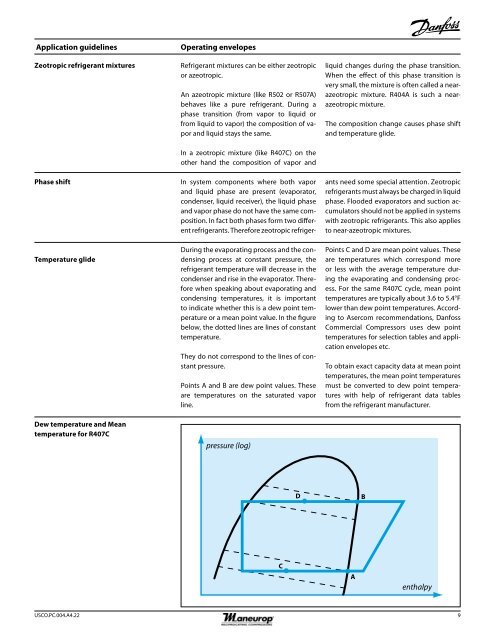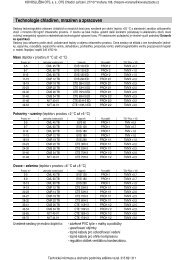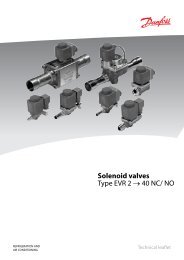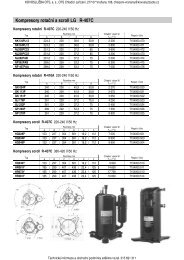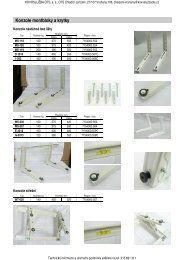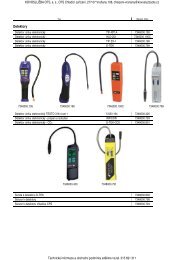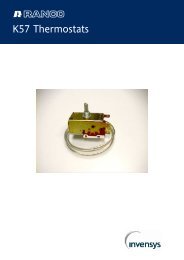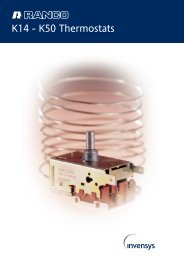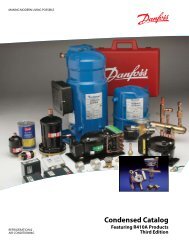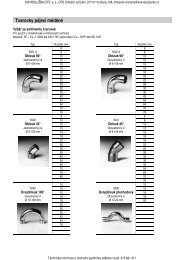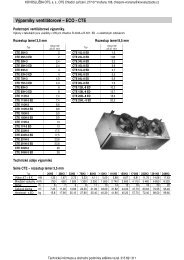Maneurop® reciprocating compressors
Maneurop® reciprocating compressors
Maneurop® reciprocating compressors
Create successful ePaper yourself
Turn your PDF publications into a flip-book with our unique Google optimized e-Paper software.
Application guidelines<br />
Zeotropic refrigerant mixtures<br />
Phase shift<br />
Temperature glide<br />
Dew temperature and Mean<br />
temperature for R407C<br />
Operating envelopes<br />
Refrigerant mixtures can be either zeotropic<br />
or azeotropic.<br />
An azeotropic mixture (like R502 or R507A)<br />
behaves like a pure refrigerant. During a<br />
phase transition (from vapor to liquid or<br />
from liquid to vapor) the composition of vapor<br />
and liquid stays the same.<br />
In a zeotropic mixture (like R407C) on the<br />
other hand the composition of vapor and<br />
During the evaporating process and the condensing<br />
process at constant pressure, the<br />
refrigerant temperature will decrease in the<br />
condenser and rise in the evaporator. Therefore<br />
when speaking about evaporating and<br />
condensing temperatures, it is important<br />
to indicate whether this is a dew point temperature<br />
or a mean point value. In the figure<br />
below, the dotted lines are lines of constant<br />
temperature.<br />
They do not correspond to the lines of constant<br />
pressure.<br />
Points A and B are dew point values. These<br />
are temperatures on the saturated vapor<br />
line.<br />
liquid changes during the phase transition.<br />
When the effect of this phase transition is<br />
very small, the mixture is often called a nearazeotropic<br />
mixture. R404A is such a nearazeotropic<br />
mixture.<br />
The composition change causes phase shift<br />
and temperature glide.<br />
In system components where both vapor<br />
and liquid phase are present (evaporator,<br />
condenser, liquid receiver), the liquid phase<br />
and vapor phase do not have the same composition.<br />
In fact both phases form two different<br />
refrigerants. Therefore zeotropic refrigerants<br />
need some special attention. Zeotropic<br />
refrigerants must always be charged in liquid<br />
phase. Flooded evaporators and suction accumulators<br />
should not be applied in systems<br />
with zeotropic refrigerants. This also applies<br />
to near-azeotropic mixtures.<br />
Points C and D are mean point values. These<br />
are temperatures which correspond more<br />
or less with the average temperature during<br />
the evaporating and condensing process.<br />
For the same R407C cycle, mean point<br />
temperatures are typically about 3.6 to 5.4°F<br />
lower than dew point temperatures. According<br />
to Asercom recommendations, Danfoss<br />
Commercial Compressors uses dew point<br />
temperatures for selection tables and application<br />
envelopes etc.<br />
To obtain exact capacity data at mean point<br />
temperatures, the mean point temperatures<br />
must be converted to dew point temperatures<br />
with help of refrigerant data tables<br />
from the refrigerant manufacturer.<br />
USCO.PC.004.A4.22 9


